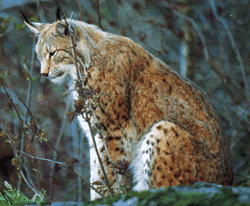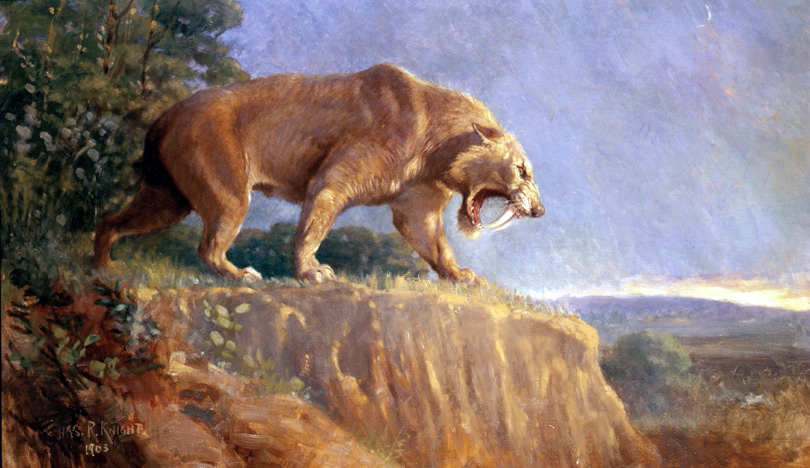We often associate "the cat" only with the common domestic house cat. Over the centuries, we have made the house cat soft, just like we are. We generally don't associate the word "heart" with cats. However, when observing the cats of the wild, we can clearly and plainly see that they're 100% pure fighting machines.
A good example of this occurred several years ago in California. A mountain lion wandered into a suburban setting, looking for food; which has become a problem in the state. A man approached the big cat, and attempted to use his open hand gestures to "shew him away." The cat lunged forward with it's incredible combination of speed and power and snapped all four of the man's fingers off with one bite. He seemed believe that it was maybe just a big house cat.
YouTube is a good source of videos showing the fighting ability of big cats, and even sometimes house cats. Even the biggest, strongest canines are no match for the bigger felines. By "bigger" I mean from the lynx or bobcat, or bigger. There is one video where a mountain lion mother stands up to a large bear, and in defense of her young, is given the impetus to put it all on the line. Another shows a mountain lion making quick work of a wolf. Wolves are the most powerful canines of all. Apparently, the larger cats have no problem with alligators or crocodiles, getting on top of them and biting the neck. Below, even a smaller jaguar has an easy time defeating an crocodile.
This dynamic reaches it's zenith with the African lion, or even the Asian lion. Lions are incredible brutes, eating hundreds of pounds of meat in one sitting. They're big, loud, nasty, and tempermental; which makes them so different from the common house cat. One video shows a large African lion sparing with a North American black bear, which seemed to show that the lion was bigger, stronger, faster, and more tenacious. Now it might be a different story with a grizzly, kodiak, or even polar bear; but the point is made I think. It is said that a lion can break a zebra's neck with one blow. The fleet cheetah would be at the opposite end; using sheer speed to hunt extremely fast antelopes.
Even the smaller thirty or forty pound lynxes or bobcats of the Northern Hemisphere can be fearless and ferocious fighters. If a lynx can stand up to a mountain lion, while a wolf apparently cannot; it seems to show that a wolf would have a big problem with a lynx or bobcat. Of course, the Eurasian lynx is native to our ancestral homeland; and for that matter, the gray wolf is also native to there. The Eurasian lynx to the left is particularly large, and they can be as heavy as 66 pounds. That one must be about 65-70 pounds.
However, despite the loud, brutish lions or tigers, most species of the cat family are pretty solitary, beautiful, graceful, almost spiritual creatures. Usually, in the northern lore, or even in Asian or Native American mythology, it's the wolf that seems to have the top spot as far as an iconic and symbolic animal. Perhaps it's because wolves possess many traits that are similar to humans. They mate for life, and they use teamwork to hunt. I don't think that cats mate for life, and they use physical attributes while usually hunting alone. At least besides female lions, who often hunt together, and groups of them are associated with a dominant male.
The metaphor "a heart of a lion" has a well grounded basis. Actually all wild cats possess this "fighting spirit," which is often obscured by their graceful way. They are very well adapted for nature's struggle. The prehistoric species of saber-toothed cats, like the American smilodon, could bring down very large prey. They became extinct only because those big game animals disappeared. Below, a smilodon restoration; showing that unlike the canine, the feline can be a monster. I think it's pretty safe to say that the saber-toothed cats knew exactly where the neck was located.
The metaphor "a heart of a lion" has a well grounded basis. Actually all wild cats possess this "fighting spirit," which is often obscured by their graceful way. They are very well adapted for nature's struggle. The prehistoric species of saber-toothed cats, like the American smilodon, could bring down very large prey. They became extinct only because those big game animals disappeared. Below, a smilodon restoration; showing that unlike the canine, the feline can be a monster. I think it's pretty safe to say that the saber-toothed cats knew exactly where the neck was located.
.




No comments:
Post a Comment